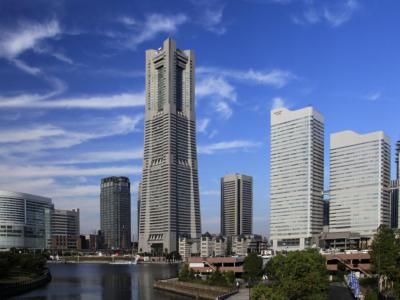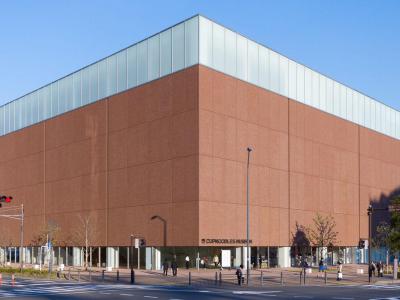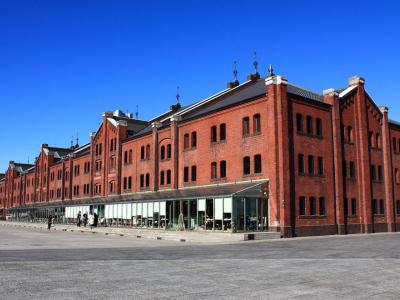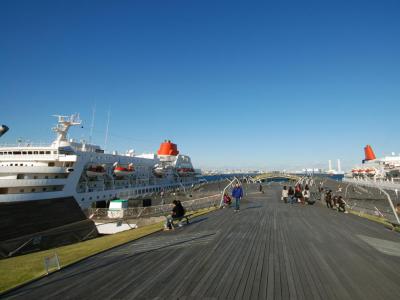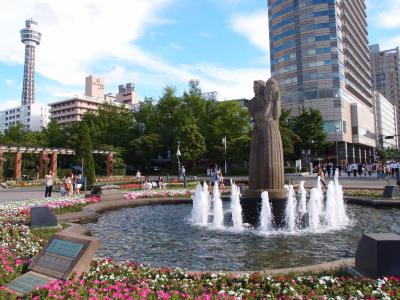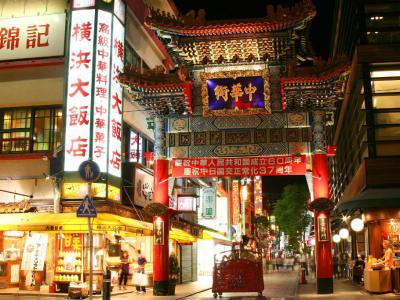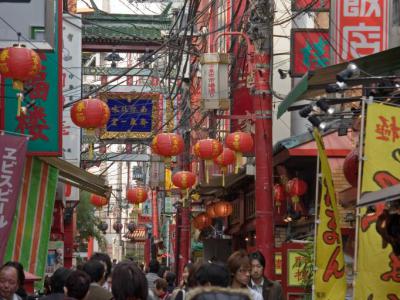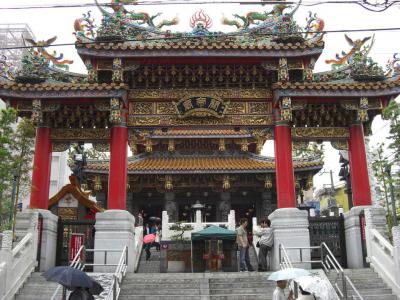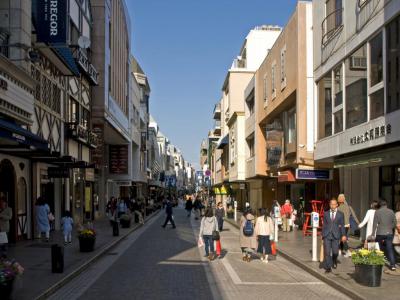Yokohama Introduction Walking Tour (Self Guided), Yokohama
Yokohama is the second-largest city in Japan. Located on Tokyo Bay, the city was once a small fishing port. It became the location of the first foreign trading port in Japan, which led to its rapid expansion. The port was primarily used for transporting silk through the 20th century.
With its long history as an important area for trade and commerce, some of the world's most successful companies are based in Yokohama. These include Nissan, Isuzu, JVCKenwood and Keikyu. Yokohama also enjoys being the first city to offer beer manufacturing, daily newspapers, a railroad and a power plant.
Yokohama has had its share of devastation. The Great Kanto earthquake of 1923 destroyed most of the city. Rebuilding efforts quickly went into place but the city once again suffered from air raids during World War II. Many of the most important buildings in the city were not fully reconstructed until the late 20th century.
Visitors to Yokohama will now find a historic city where ultra-modern architecture unites with ancient charm. Some of the older buildings in the city that have been refurbished include the Red Brick Warehouse and Kanteibyo Temple. The Red Brick Warehouse is now largely used as a shopping center while the Kanteibyo Temple is an important piece of culture in the midst of the city.
Yokohama is also known for shopping. There are numerous pedestrian shopping streets that cater to those looking for souvenirs, delicious food, people watching or all three. Motomachi Shopping Street and Ichiba-Dori Shopping Street are two pedestrian areas. Shopping in Yokohama is fun and safe.
One of the most notable sights in Yokohama is the Landmark Tower with its breathtaking, 360-degree views of the city. Visitors should not forget to spend some time in Japan's first Chinatown or enjoy the CupNoodles Museum.
Take this self-paced walking tour to see many of the most beautiful, historical and culturally significant sights of Yokohama, Japan.
With its long history as an important area for trade and commerce, some of the world's most successful companies are based in Yokohama. These include Nissan, Isuzu, JVCKenwood and Keikyu. Yokohama also enjoys being the first city to offer beer manufacturing, daily newspapers, a railroad and a power plant.
Yokohama has had its share of devastation. The Great Kanto earthquake of 1923 destroyed most of the city. Rebuilding efforts quickly went into place but the city once again suffered from air raids during World War II. Many of the most important buildings in the city were not fully reconstructed until the late 20th century.
Visitors to Yokohama will now find a historic city where ultra-modern architecture unites with ancient charm. Some of the older buildings in the city that have been refurbished include the Red Brick Warehouse and Kanteibyo Temple. The Red Brick Warehouse is now largely used as a shopping center while the Kanteibyo Temple is an important piece of culture in the midst of the city.
Yokohama is also known for shopping. There are numerous pedestrian shopping streets that cater to those looking for souvenirs, delicious food, people watching or all three. Motomachi Shopping Street and Ichiba-Dori Shopping Street are two pedestrian areas. Shopping in Yokohama is fun and safe.
One of the most notable sights in Yokohama is the Landmark Tower with its breathtaking, 360-degree views of the city. Visitors should not forget to spend some time in Japan's first Chinatown or enjoy the CupNoodles Museum.
Take this self-paced walking tour to see many of the most beautiful, historical and culturally significant sights of Yokohama, Japan.
How it works: Download the app "GPSmyCity: Walks in 1K+ Cities" from Apple App Store or Google Play Store to your mobile phone or tablet. The app turns your mobile device into a personal tour guide and its built-in GPS navigation functions guide you from one tour stop to next. The app works offline, so no data plan is needed when traveling abroad.
Yokohama Introduction Walking Tour Map
Guide Name: Yokohama Introduction Walking Tour
Guide Location: Japan » Yokohama (See other walking tours in Yokohama)
Guide Type: Self-guided Walking Tour (Sightseeing)
# of Attractions: 9
Tour Duration: 2 Hour(s)
Travel Distance: 3.7 Km or 2.3 Miles
Author: emma
Sight(s) Featured in This Guide:
Guide Location: Japan » Yokohama (See other walking tours in Yokohama)
Guide Type: Self-guided Walking Tour (Sightseeing)
# of Attractions: 9
Tour Duration: 2 Hour(s)
Travel Distance: 3.7 Km or 2.3 Miles
Author: emma
Sight(s) Featured in This Guide:
- Landmark Tower and Sky Garden Observatory
- CupNoodles Museum Yokohama
- Red Brick Warehouse
- Osanbashi Pier
- Yamashita Park
- Choyomon Gate and Chinatown
- Ichiba-Dori Shopping Street
- Kanteibyo Temple
- Motomachi Shopping Street
1) Landmark Tower and Sky Garden Observatory (must see)
The Yokohama Landmark Tower is a well-known landmark in the Yokohama skyline, noted for being the third tallest building and the fifth tallest structure in Japan. It stands at a height of 296.3 meters (972 feet) and dominates the Minato Mirai 21 district, conveniently located near the Yokohama Museum of Art. Until 2014, it held the title of Japan's tallest building until it was surpassed by Abeno Harukas, showcasing its iconic status.
This skyscraper serves multiple functions, housing a luxurious five-star hotel spanning floors 49 to 70, offering 603 rooms for discerning guests. The lower floors feature various shops, restaurants, clinics, and offices, ensuring a diverse range of amenities for visitors and tenants. The building's stability is maintained by two tuned mass dampers on the 71st floor, crucial for mitigating seismic activity and wind-induced sway.
A major attraction of the Yokohama Landmark Tower is the Sky Garden Observatory on the 69th floor, providing a stunning 360-degree panoramic view of Yokohama city and, on clear days, Mount Fuji. Viewing the city from this height offers unparalleled visuals, captivating visitors regardless of the time of day. The observatory is photographer-friendly, allowing the use of lens hoods and tripods. However, the windows for viewing Mount Fuji are not ideally positioned, making sunset a popular time for glimpsing the iconic peak.
The tower also boasts the world's fastest elevators, which reach the 69th floor in just 40 seconds, minimizing wait times and enhancing the visitor experience. The design and construction of the Yokohama Landmark Tower were a collaboration between Mitsubishi Jisho Sekkei and KlingStubbins, reflecting both innovative engineering and aesthetic design.
This skyscraper serves multiple functions, housing a luxurious five-star hotel spanning floors 49 to 70, offering 603 rooms for discerning guests. The lower floors feature various shops, restaurants, clinics, and offices, ensuring a diverse range of amenities for visitors and tenants. The building's stability is maintained by two tuned mass dampers on the 71st floor, crucial for mitigating seismic activity and wind-induced sway.
A major attraction of the Yokohama Landmark Tower is the Sky Garden Observatory on the 69th floor, providing a stunning 360-degree panoramic view of Yokohama city and, on clear days, Mount Fuji. Viewing the city from this height offers unparalleled visuals, captivating visitors regardless of the time of day. The observatory is photographer-friendly, allowing the use of lens hoods and tripods. However, the windows for viewing Mount Fuji are not ideally positioned, making sunset a popular time for glimpsing the iconic peak.
The tower also boasts the world's fastest elevators, which reach the 69th floor in just 40 seconds, minimizing wait times and enhancing the visitor experience. The design and construction of the Yokohama Landmark Tower were a collaboration between Mitsubishi Jisho Sekkei and KlingStubbins, reflecting both innovative engineering and aesthetic design.
2) CupNoodles Museum Yokohama (must see)
The Cup Noodles Museum is a fun and interactive museum in Yokohama. It is a four-story museum that provides exhibits and attractions dedicated to instant noodles and its creator and founder, Momofuku Ando. The visitors will learn about the history of instant noodles and Momofuku Ando's story.
The CupNoodles Museum has many different areas that visitors can experience and fully immerse themselves in the world of instant ramen. The Chicken Ramen Factory lets patrons make their own noodles, and the CupNoodles Factory allows them to design a cup, choose their broth and pick four toppings from a selection to create a unique cup of noodles they can then enjoy.
The Instant Noodles History Cube and the Momofuku Ando Story are historical exhibits in the museum. The Noodles Bazaar displays a different kind of noodles. Visitors can even try them to experience the tastes and textures of the noodles from around the world.
The museum also includes CupNoodles Park. The interactive exhibit is specifically geared toward children from ages three to 12. They can pretend to be a noodle as they go through the life-size manufacturing process. They will enter a noodle net (climbing net), a seasoning pool (ball pit), a virtual fryer, and a slide. They can even enter a life-size noodle cup.
The CupNoodles Museum has many different areas that visitors can experience and fully immerse themselves in the world of instant ramen. The Chicken Ramen Factory lets patrons make their own noodles, and the CupNoodles Factory allows them to design a cup, choose their broth and pick four toppings from a selection to create a unique cup of noodles they can then enjoy.
The Instant Noodles History Cube and the Momofuku Ando Story are historical exhibits in the museum. The Noodles Bazaar displays a different kind of noodles. Visitors can even try them to experience the tastes and textures of the noodles from around the world.
The museum also includes CupNoodles Park. The interactive exhibit is specifically geared toward children from ages three to 12. They can pretend to be a noodle as they go through the life-size manufacturing process. They will enter a noodle net (climbing net), a seasoning pool (ball pit), a virtual fryer, and a slide. They can even enter a life-size noodle cup.
3) Red Brick Warehouse
The Red Brick Warehouse is a shopping mall, banquet hall, and event venue. Officially called the Newport Pier Bonded Warehouse, the historical edifice, designed as a custom building for incoming freight at the Port of Yokohama, became one of the most recognizable landmarks in Yokohama.
The Yokohama Red Brick Warehouse was planned as a part of the construction of harbor facilities in the late 19th century. Both buildings of the Warehouse were finished in 1913. The Red Brick Warehouse was designed by the Japanese architect Yorinaka Tsumaki, famous for his style mixing elements of classic Western European with Japanese architecture.
The Great Kanto Earthquake of 1923 damaged both buildings. Reconstruction efforts were completed in 1930. However, the occupying forces of the United States seized the buildings after World War II. Though the Warehouse was returned to Japan in the 1950s, the edifice gradually fell into disrepair and was abandoned in 1989.
Japanese architectural firm Takenaka Corporation took over the restoration and restructuring of the buildings in the 1990s. They officially opened as Yokohama Red Brick Warehouse in 2002. Building one is a three-story event venue that hosts art exhibitions, film festivals, music competitions, and plays. Building two is a three-story shopping mall with restaurants and an open balcony.
The Yokohama Red Brick Warehouse was planned as a part of the construction of harbor facilities in the late 19th century. Both buildings of the Warehouse were finished in 1913. The Red Brick Warehouse was designed by the Japanese architect Yorinaka Tsumaki, famous for his style mixing elements of classic Western European with Japanese architecture.
The Great Kanto Earthquake of 1923 damaged both buildings. Reconstruction efforts were completed in 1930. However, the occupying forces of the United States seized the buildings after World War II. Though the Warehouse was returned to Japan in the 1950s, the edifice gradually fell into disrepair and was abandoned in 1989.
Japanese architectural firm Takenaka Corporation took over the restoration and restructuring of the buildings in the 1990s. They officially opened as Yokohama Red Brick Warehouse in 2002. Building one is a three-story event venue that hosts art exhibitions, film festivals, music competitions, and plays. Building two is a three-story shopping mall with restaurants and an open balcony.
4) Osanbashi Pier
The Osanbashi Pier is the primary dock for international passengers at the Port of Yokohama. Constructed in 1896, it is the oldest existing pier in the city. It was designed by Henry Spencer Palmer, a British military engineer, and funded by the Government of Japan.
The port opened in 1859 after signing the Treaty of Amity and Commerce. The first ports were small, stone wharves. They were too shallow for ocean vessels to dock, which required the use of barges for people and goods. Osanbashi Pier was designed to allow a more efficient method of reaching the shore.
The Pier's most recent reconstruction, completed in 2002, crafted a new passenger terminal with new areas as customs, an immigration lobby, a ticketing booth, and numerous shops and cafes.
Those who visit Osanbashi Pier will find that it is one of the best spots in the city to see the Yokohama Three Towers. The rooftop observation deck has planted grass areas that can be enjoyed by the public as they take in the sights of the city.
The port opened in 1859 after signing the Treaty of Amity and Commerce. The first ports were small, stone wharves. They were too shallow for ocean vessels to dock, which required the use of barges for people and goods. Osanbashi Pier was designed to allow a more efficient method of reaching the shore.
The Pier's most recent reconstruction, completed in 2002, crafted a new passenger terminal with new areas as customs, an immigration lobby, a ticketing booth, and numerous shops and cafes.
Those who visit Osanbashi Pier will find that it is one of the best spots in the city to see the Yokohama Three Towers. The rooftop observation deck has planted grass areas that can be enjoyed by the public as they take in the sights of the city.
5) Yamashita Park (must see)
The Yamashita Park is a nearly 800,000-square-foot public park, located right in front of Yokohama Port. The park was first opened in 1930 as part of the city’s reconstruction and recovery after the Great Kanto Earthquake in 1923. The city government chose to use rubble from the destroyed Kannai commercial district to build a public-use park on the waterfront.
The park contains public green space with trees and flower beds. It is also home to fountains and memorials. A large number of open-air art installations can be enjoyed at the park. Among these is The Guardian of Water sculpture, created by Donal Hort, an American sculptor. There is also the Monument of the Children's song Seagull Sailor Man, Statue of the Girl with Red Shoes, Monument of General Artemio Ricarte - Philippine General, Yokohama Indian Water Fountain, and other art displays.
The Hikawa Maru is a Japanese ocean liner built in 1929 that functions as a museum ship. Exhibits showcase the history of the port, the pier, and the ocean liner itself. Visitors can explore the ship's decks, cabins, and engine rooms.
The park contains public green space with trees and flower beds. It is also home to fountains and memorials. A large number of open-air art installations can be enjoyed at the park. Among these is The Guardian of Water sculpture, created by Donal Hort, an American sculptor. There is also the Monument of the Children's song Seagull Sailor Man, Statue of the Girl with Red Shoes, Monument of General Artemio Ricarte - Philippine General, Yokohama Indian Water Fountain, and other art displays.
The Hikawa Maru is a Japanese ocean liner built in 1929 that functions as a museum ship. Exhibits showcase the history of the port, the pier, and the ocean liner itself. Visitors can explore the ship's decks, cabins, and engine rooms.
6) Choyomon Gate and Chinatown (must see)
Yokohama Chinatown is the largest Chinatown in Japan. The area has about 250 shops and restaurants that cater mainly to tourists who want to see the historic neighborhood.
Yokohama Chinatown can trace its roots to 1859 with the opening of the seaport. Ferry services from Shanghai and Hong Kong to Yokohama brought many Chinese immigrants. They soon established a school, a community center, shops, and restaurants.
Issues that hampered Chinatown's growth began almost as soon as Chinese immigrants arrived. Laws in Yokohama prevented Chinese citizens from performing certain types of work. The Great Kanto Earthquake caused massive death and destruction. Perhaps the biggest obstacle to Chinatown's growth was World War II.
Things began turning around after the end of the war. The goodwill gate was built in 1955. Chinatown became officially recognized for the first time, given the name Yokohama Chinatown or, in Japanese, Yokohama Chukagai.
Tourism became very important to Chinatown in the late 20th century. Once Japan established diplomatic relations with China, sightseeing in Yokohama Chinatown became a popular pastime. It also became a primary destination for those visiting Yokohama.
There are more than 150 Chinese restaurants in Yokohama Chinatown. They serve cuisine from the many regions of China as well as Taiwan. There are also medicinal cafes and buffets.
Tourists can browse dozens of shops and entertainment venues. Among these are arcades, photography studios, karaoke bars and much more. There are even spots where tourists can learn how to make dim sum, paper lanterns, and other traditional Chinese crafts.
Yokohama Chinatown can trace its roots to 1859 with the opening of the seaport. Ferry services from Shanghai and Hong Kong to Yokohama brought many Chinese immigrants. They soon established a school, a community center, shops, and restaurants.
Issues that hampered Chinatown's growth began almost as soon as Chinese immigrants arrived. Laws in Yokohama prevented Chinese citizens from performing certain types of work. The Great Kanto Earthquake caused massive death and destruction. Perhaps the biggest obstacle to Chinatown's growth was World War II.
Things began turning around after the end of the war. The goodwill gate was built in 1955. Chinatown became officially recognized for the first time, given the name Yokohama Chinatown or, in Japanese, Yokohama Chukagai.
Tourism became very important to Chinatown in the late 20th century. Once Japan established diplomatic relations with China, sightseeing in Yokohama Chinatown became a popular pastime. It also became a primary destination for those visiting Yokohama.
There are more than 150 Chinese restaurants in Yokohama Chinatown. They serve cuisine from the many regions of China as well as Taiwan. There are also medicinal cafes and buffets.
Tourists can browse dozens of shops and entertainment venues. Among these are arcades, photography studios, karaoke bars and much more. There are even spots where tourists can learn how to make dim sum, paper lanterns, and other traditional Chinese crafts.
7) Ichiba-Dori Shopping Street
The Ichiba-Dori Shopping Street is one of the primary streets in Yokohama, Chinatown. It runs north and south from Chukagai Odori and Kanteibyo Road. The Ichiba-Dori Shopping Street is easily located due to the traditional gates at each end of the street.
The street was established in the 1920s, when food stores started popping up to provide produce, fish, and meat products to the area's restaurants. Today, the pedestrian street offers much more than grocers and butchers. It abounds with full-service restaurants and street food stations. Tourists can grab Chinese dumplings while they walk or sit down for a multi-course meal.
In keeping with its name, there are plenty of spots to buy souvenirs on the Ichiba-Dori Shopping Street. There are also palm readers who are happy to read the future for a price.
The narrow street is decorated with Chinese paper lanterns, hanging from above. They illuminate at night, creating a welcoming atmosphere that is reminiscent of the streets of Hong Kong and Shanghai.
The street was established in the 1920s, when food stores started popping up to provide produce, fish, and meat products to the area's restaurants. Today, the pedestrian street offers much more than grocers and butchers. It abounds with full-service restaurants and street food stations. Tourists can grab Chinese dumplings while they walk or sit down for a multi-course meal.
In keeping with its name, there are plenty of spots to buy souvenirs on the Ichiba-Dori Shopping Street. There are also palm readers who are happy to read the future for a price.
The narrow street is decorated with Chinese paper lanterns, hanging from above. They illuminate at night, creating a welcoming atmosphere that is reminiscent of the streets of Hong Kong and Shanghai.
8) Kanteibyo Temple
Kanteibyo Temple, located in the heart of Yokohama's Chinatown, is a significant spiritual and cultural site. It houses the statue of Guan Gong (Guan Yu), a revered figure in Chinese mythology known for his bravery and loyalty, particularly from the historical novel "Romance of the Three Kingdoms." Guan Gong is worshipped at the temple not only as a symbol of martial prowess but also as a deity associated with prosperity in business and finance.
The temple has a history marked by resilience and reconstruction. Established in 1871, it has been destroyed and rebuilt several times due to natural disasters and wartime events. Despite facing destruction during the Great Kanto Earthquake in 1923, air attacks in World War II, and lightning strikes in 1986, it was rebuilt each time. The current structure, completed in 2000, carries on the tradition of honoring Chinese deities and symbolizes the community's enduring spirit.
Kanteibyo Temple's architecture and design are captivating, featuring a vibrant red exterior and intricate details in line with traditional Chinese styles. Dragon statues guard the entrance, symbolizing protection and power, while the interior is adorned with lavish gold decorations, reflecting the temple's spiritual importance. At its center stands the statue of Guan Yu, drawing worshippers seeking blessings for prosperity.
Besides Guan Gong, the temple is also a place where visitors can pay homage to the Jade Emperor and other Chinese gods believed to bring good fortune. Thus, Kanteibyo Temple serves as more than just a religious site; it is a symbol of faith, cultural heritage, and community resilience in Yokohama's Chinatown, attracting both believers and curious visitors alike.
The temple has a history marked by resilience and reconstruction. Established in 1871, it has been destroyed and rebuilt several times due to natural disasters and wartime events. Despite facing destruction during the Great Kanto Earthquake in 1923, air attacks in World War II, and lightning strikes in 1986, it was rebuilt each time. The current structure, completed in 2000, carries on the tradition of honoring Chinese deities and symbolizes the community's enduring spirit.
Kanteibyo Temple's architecture and design are captivating, featuring a vibrant red exterior and intricate details in line with traditional Chinese styles. Dragon statues guard the entrance, symbolizing protection and power, while the interior is adorned with lavish gold decorations, reflecting the temple's spiritual importance. At its center stands the statue of Guan Yu, drawing worshippers seeking blessings for prosperity.
Besides Guan Gong, the temple is also a place where visitors can pay homage to the Jade Emperor and other Chinese gods believed to bring good fortune. Thus, Kanteibyo Temple serves as more than just a religious site; it is a symbol of faith, cultural heritage, and community resilience in Yokohama's Chinatown, attracting both believers and curious visitors alike.
9) Motomachi Shopping Street
The Motomachi Shopping Street is a historic shopping district in Yokohama. Its history dates to 1859, when the area was divided into two districts for Japanese businesses and foreign residents. The area became the residence of thousands of foreign people, who were living and working here, and businesses built up around them.
The area changed over the years due to natural disasters and external forces. The street renovation project started in 1979 and finished in 1985.
The symbol of Motomachi Shopping Street is "Fly Through the Light," a 34-foot-tall phoenix-shaped sculpture made from blue stainless-steel pipe.
The Motomachi Shopping Street hosts over 100 shops, offices, and restaurants. Some of the shops are Seven Sisters, Lacoste, and Brooks Brothers. Eateries range from elegant, full-service restaurants to pastry shops to Starbucks.
There are also the entertainment options like art galleries, a photography studio, spa salons, and even a pet grooming spot.
The area changed over the years due to natural disasters and external forces. The street renovation project started in 1979 and finished in 1985.
The symbol of Motomachi Shopping Street is "Fly Through the Light," a 34-foot-tall phoenix-shaped sculpture made from blue stainless-steel pipe.
The Motomachi Shopping Street hosts over 100 shops, offices, and restaurants. Some of the shops are Seven Sisters, Lacoste, and Brooks Brothers. Eateries range from elegant, full-service restaurants to pastry shops to Starbucks.
There are also the entertainment options like art galleries, a photography studio, spa salons, and even a pet grooming spot.
Walking Tours in Yokohama, Japan
Create Your Own Walk in Yokohama
Creating your own self-guided walk in Yokohama is easy and fun. Choose the city attractions that you want to see and a walk route map will be created just for you. You can even set your hotel as the start point of the walk.
Kamakura Temples Walking Tour
The vicinity of Yokohama abounds in Buddhist temples. Some of them are listed as national heritage. The most significant of them are found in the historic town of Kamakura, renowned for its rich religious scene.
Hase-dera Temple, perched on a hillside, is famous for its beautiful gardens and the towering Kannon statue, representing the goddess of mercy. Visitors can enjoy panoramic views of... view more
Tour Duration: 2 Hour(s)
Travel Distance: 4.7 Km or 2.9 Miles
Hase-dera Temple, perched on a hillside, is famous for its beautiful gardens and the towering Kannon statue, representing the goddess of mercy. Visitors can enjoy panoramic views of... view more
Tour Duration: 2 Hour(s)
Travel Distance: 4.7 Km or 2.9 Miles
The Most Popular Cities
/ view all



